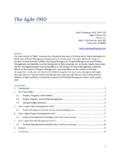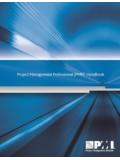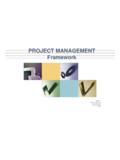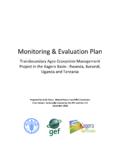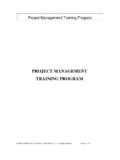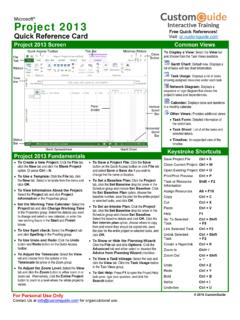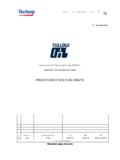Transcription of Lean Management Standards: Office
1 lean Management standards : Office 2014 DMLC Reprinted by Permission Few<25% Some<50% Most>75% All=100% From Creating a lean Culture, 3rd Edition Leader Standard Work Date: Location: Diagnostic Questions: 1. Do leaders have standard work? Do they follow it? Do they routinely have it with them? 2. Is leader standard work regularly reviewed for updating based on new issues and changes? 3. Are standard work documents used as working documents to record notes and observations? 4. Are standard work documents reviewed at least weekly with leaders supervisors? 5. Is there a defined place where completed standard work documents are stored? Is it used? 6. Has leader standard work been used in this area in transitions between leaders? Progress Notes 1 No leader standard work is in evidence.
2 Some leaders have heard of the idea of leaders standard work. Most leaders see standard work as applicable to repetitive production work only. 2 Leader standard work exists for a few isolated positions. Where it exists, leader standard work is carried out some of the time and filled out irregularly. Leader standard work has not been revised. Most leaders talk about it as a compliance, check the box exercise. 3 Standard work is in place for all leaders in department, value stream, team lead through value stream sponsor. The standard work for all leaders has been revised once. Most leaders carry their standard work with them, follow it, and use it as a working daily document. Most leaders understand the benefits of standard work and can give examples that illustrate how it has helped them in their work.
3 4 All leaders carry and follow leader standard work and use it as a working daily record. All superiors regularly review subordinates' standard work documents at least weekly. All leaders can identify how standard work benefits them and the process. Standard work is regularly reviewed and revised. 5 Standard work is regularly reviewed at least weekly as a monitoring and communication method. Subordinate regularly review it with supervisor to uncover patterns and consider revisions. A standard process is followed for turning in, storing, and reviewing completed standard work documents for each leader. All transitions between leaders include review and walkthrough of leader standard work. All new leaders follow standard work from day one on the job. Pre-Implementation Beginning Implementation First Recognition State System Stabilizing Sustainable System lean Management standards : Office 2014 DMLC Reprinted by Permission Few<25% Some<50% Most>75% All=100% From Creating a lean Culture, 3rd Edition Value Stream Mapping Date: Location: Diagnostic Questions: 1.
4 Are there documented plans for improvement in each area in the value stream, or at least each department? 2. Are process improvements posted and visual in each area? 3. Are value stream maps used to identify and track process improvements? 4. Are value stream maps available for current and future state? 5. Do future state maps show planned kaizens, completion status of kaizens, and specific targets for improvement in process measures? 6. Who prepares value stream maps for the area? How many of the area's leaders are proficient value stream mappers? Progress Notes 1 Value stream maps are not in use, or were used once but are out of date. They are not part of the area s approach to improvement. Few people, if any in the area are proficient at value stream mapping. 2 Value stream maps can be seen posted in the area, may once have been used as an improvement-planning tool, but they are out of date.
5 A few technical specialists know how to map value streams. Most of the leaders do not. Value stream maps, when present, show the current state only. Or, if future state maps are present, they are out of date. 3 Most areas have visible plans for improvement; many of these shown as current and future state value stream maps with kaizen bursts indicating planned improvement, also reflected on A3s. Some of the future state maps show planned improvement in specific process measures, such as cycle time, % complete and accurate, process time as a percentage of cycle time. In areas with current value stream maps, some team leaders are proficient value stream mappers and draw their own maps. 4 All value streams display current state and 90-day future state maps showing improvement goals for process measures and kaizens to achieve goals.
6 Team leaders in the value stream are proficient value stream mappers and draw their own maps. Mapping is a tool used systematically to understand opportunities large and small. Completion status of kaizens is shown on the value stream maps, linked to A3 displays, and reflected in status of progress against 90-day goals. 5 Value stream maps are regularly used in the area s communication process. Front line leaders teach value stream mapping. All leaders (managers, directors, VPs) are proficient mappers. All departments and teams use posted value stream maps to show their improvement goals. Each area s process performance (down to the work team) is reflected in the current state measures summary on its value stream map ( cycle time, process as a % of cycle time, % complete and accurate, productivity, etc.)
7 Pre-Implementation Beginning Implementation First Recognition State System Stabilizing Sustainable System lean Management standards : Office 2014 DMLC Reprinted by Permission Few<25% Some<50% Most>75% All=100% From Creating a lean Culture, 3rd Edition Visual Process Controls Date: Location: Diagnostic Questions: 1. Are visual controls in evidence: for balancing workloads? To show pace and progression of work? For exception Management ? 2. Are reasons for misses or flow interrupters described clearly and specifically enough to decide what next steps to take? 3. Are visuals regularly reviewed and used to drive improvement? Are the improvements stimulated by visuals limited to crisis situations, or are there many, often small, improvements driven by visuals? 4. Are visuals regularly used for support tasks, material replenishment, rotation of tasks, planned absences, skill versatility?
8 5. Are visuals revised and changed as conditions change and issues either emerge or are resolved? 6. Are visuals regularly signed off / initialed by leaders in the area? 7. Are visuals self-documented with "who does what here when" information at or on the visual controls themselves? Progress Notes 1 There are no visual controls in evidence 2 Production or exception visuals are used only to show the status of work: who s doing what, and to balance workloads. Tracking charts for value adding and support processes complete for few days or intervals of observation; often filled in irregularly, focus only on production numbers. Reasons for misses are absent or too vague for action There is no or only irregular daily review of process or production exception visuals. Response to information on the visuals is either absent or irregular.
9 Visuals are a check the box activity. 3 Some support processes and systems have visual tracking for completion or reliability. Production or process tracking charts, when they exist, are current. Most reasons for misses are specific, complete and actionable with little additional information. Visuals are reviewed daily or on a regular schedule, often drive specific action assignments on identified major interrupters or problems. 4 Tracking charts are in use for each flow path, value stream, handoff, production area. Tracking charts reflect expected versus actual pace or progression of work. Visuals added, discontinued as needs change. All reasons for misses / exceptions specific, complete, actionable with little added information. Visuals are reviewed daily, and regularly leading to specific assignments on small and large interrupters.
10 5 Visuals are in regular use for support tasks and systems through the value stream. All process and production charts are initialed at least daily by department and value stream leaders, and occasionally by executives walking in the area. Visuals are regularly analyzed to identify most frequent interrupters or problems, which drive root case problem solving and improvement. Pre-Implementation Beginning Implementation First Recognition State System Stabilizing Sustainable System lean Management standards : Office 2014 DMLC Reprinted by Permission Few<25% Some<50% Most>75% All=100% From Creating a lean Culture, 3rd Edition Standard Accountability Process Date: Location: Diagnostic Questions: 1. Do regularly scheduled meetings focus on the status of processes as well as on results? How often?
